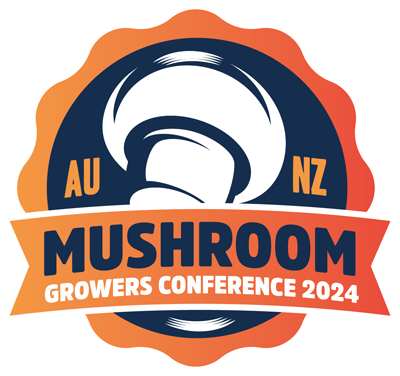
Dr Michael Kertesz
University Of SydneyBalancing nitrogen supply and demand in button mushroom composting and cropping
Button mushrooms (Agaricus bisporus) are an excellent source of protein, containing many of the essential amino acids that humans need. To produce this protein, nitrogen inputs to composting need to be carefully managed. The main nitrogen sources used for Australian mushroom production are poultry manure, synthetic nitrogen, and smaller amounts of other N-containing feedstocks. There total amount of nitrogen added by Australian composters varies considerably, with overall inputs ranging from 6.5-80 kg N /tonne Phase 1 compost. Only about 12% of this nitrogen is recovered in the mushroom crop as protein – the remainder is lost in compost leachate or as gaseous nitrogen compounds, (20-30% of input N) or is discarded with compost/casing after cropping (50-60% of input N). Gaseous emissions consist mainly of ammonia from protein breakdown in the thermophilic phase and nitrous oxide from the activity of nitrifying bacteria during pasteurization and curing.
To increase mushroom cap production, most mushroom yards add a slow-release nitrogen supplement to the compost before cropping. We have tested the effect of replacing this treatment with the addition of different nitrogen sources directly into the compost at the pinning stage before each flush. Depending on the N source used, this increased yields by up to 13%, and led to a significant increase in mushroom protein content. More importantly, second or third flush mushrooms had a much higher N-content (6.7% dry weight) than first flush mushrooms (4.3%). The results demonstrate that optimization of the timing and amounts of nitrogen additions during cropping can improve yield and nutritional value of the crop.
Dr. Michael Kertesz
Michael Kertesz is Associate Professor for Soil Microbiology in the School of Life and Environmental Sciences at the University of Sydney. He completed his PhD at the University of Cambridge, and then spend twenty years as a research microbiologist, first at the Swiss Federal Technical University (ETH) and then at the University of Manchester. His research focussed on how bacteria and fungi react to changes in their surroundings, especially in soil and around the roots of agricultural crop plants.
Michael moved to the University of Sydney in 2009 and applied his knowledge of microbe-soil interactions to the field of mushroom research. He studied mushroom-microbe interactions in compost as part of MU100021 Improving consistency of mushroom compost through control of biotic and abiotic parameters, which revealed the presence of thousands of unknown bacteria in mushroom compost, and explored methods for early detection of mushroom pathogens in MU12007 Development of a pilot mushroom farm disease monitoring scheme. He is currently investigating the transformations of nitrogen in mushroom compost (MU17004 Optimize nitrogen transformations in Mushroom production) and developing a database of bio‐markers for compost quality control to maximise mushroom production yield (MU17006). Michael’s mushroom research addresses questions of sustainability for commercial production of mushroom compost, aiming to understand microbial interactions in the compost in order to optimize yield and quality of mushroom crops.
